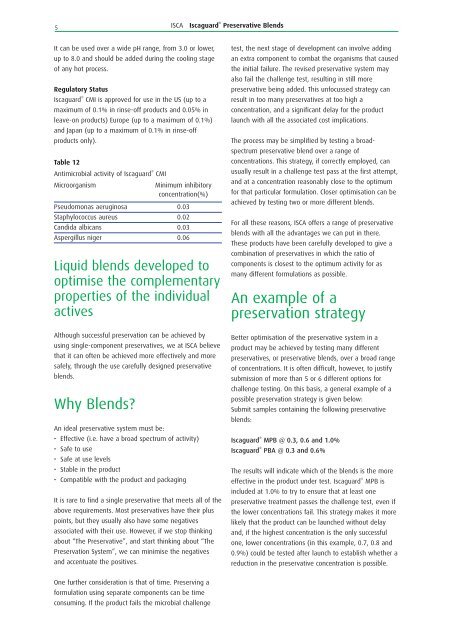ISCAGUARD ® Preservatives for Personal Care - ISCA UK Ltd
ISCAGUARD ® Preservatives for Personal Care - ISCA UK Ltd
ISCAGUARD ® Preservatives for Personal Care - ISCA UK Ltd
You also want an ePaper? Increase the reach of your titles
YUMPU automatically turns print PDFs into web optimized ePapers that Google loves.
5<br />
It can be used over a wide pH range, from 3.0 or lower,<br />
up to 8.0 and should be added during the cooling stage<br />
of any hot process.<br />
Regulatory Status<br />
Iscaguard <strong>®</strong><br />
CMI is approved <strong>for</strong> use in the US (up to a<br />
maximum of 0.1% in rinse-off products and 0.05% in<br />
leave-on products) Europe (up to a maximum of 0.1%)<br />
and Japan (up to a maximum of 0.1% in rinse-off<br />
products only).<br />
Table 12<br />
Antimicrobial activity of Iscaguard <strong>®</strong><br />
CMI<br />
Microorganism Minimum inhibitory<br />
concentration(%)<br />
Pseudomonas aeruginosa 0.03<br />
Staphylococcus aureus 0.02<br />
Candida albicans 0.03<br />
Aspergillus niger 0.06<br />
Liquid blends developed to<br />
optimise the complementary<br />
properties of the individual<br />
actives<br />
Although successful preservation can be achieved by<br />
using single-component preservatives, we at <strong>ISCA</strong> believe<br />
that it can often be achieved more effectively and more<br />
safely, through the use carefully designed preservative<br />
blends.<br />
Why Blends?<br />
An ideal preservative system must be:<br />
• Effective (i.e. have a broad spectrum of activity)<br />
• Safe to use<br />
• Safe at use levels<br />
• Stable in the product<br />
• Compatible with the product and packaging<br />
It is rare to find a single preservative that meets all of the<br />
above requirements. Most preservatives have their plus<br />
points, but they usually also have some negatives<br />
associated with their use. However, if we stop thinking<br />
about “The Preservative”, and start thinking about “The<br />
Preservation System”, we can minimise the negatives<br />
and accentuate the positives.<br />
One further consideration is that of time. Preserving a<br />
<strong>for</strong>mulation using separate components can be time<br />
consuming. If the product fails the microbial challenge<br />
<strong>ISCA</strong> Iscaguard <strong>®</strong><br />
Preservative Blends<br />
test, the next stage of development can involve adding<br />
an extra component to combat the organisms that caused<br />
the initial failure. The revised preservative system may<br />
also fail the challenge test, resulting in still more<br />
preservative being added. This unfocussed strategy can<br />
result in too many preservatives at too high a<br />
concentration, and a significant delay <strong>for</strong> the product<br />
launch with all the associated cost implications.<br />
The process may be simplified by testing a broadspectrum<br />
preservative blend over a range of<br />
concentrations. This strategy, if correctly employed, can<br />
usually result in a challenge test pass at the first attempt,<br />
and at a concentration reasonably close to the optimum<br />
<strong>for</strong> that particular <strong>for</strong>mulation. Closer optimisation can be<br />
achieved by testing two or more different blends.<br />
For all these reasons, <strong>ISCA</strong> offers a range of preservative<br />
blends with all the advantages we can put in there.<br />
These products have been carefully developed to give a<br />
combination of preservatives in which the ratio of<br />
components is closest to the optimum activity <strong>for</strong> as<br />
many different <strong>for</strong>mulations as possible.<br />
An example of a<br />
preservation strategy<br />
Better optimisation of the preservative system in a<br />
product may be achieved by testing many different<br />
preservatives, or preservative blends, over a broad range<br />
of concentrations. It is often difficult, however, to justify<br />
submission of more than 5 or 6 different options <strong>for</strong><br />
challenge testing. On this basis, a general example of a<br />
possible preservation strategy is given below:<br />
Submit samples containing the following preservative<br />
blends:<br />
Iscaguard <strong>®</strong><br />
Iscaguard <strong>®</strong><br />
MPB @ 0.3, 0.6 and 1.0%<br />
PBA @ 0.3 and 0.6%<br />
The results will indicate which of the blends is the more<br />
effective in the product under test. Iscaguard <strong>®</strong><br />
MPB is<br />
included at 1.0% to try to ensure that at least one<br />
preservative treatment passes the challenge test, even if<br />
the lower concentrations fail. This strategy makes it more<br />
likely that the product can be launched without delay<br />
and, if the highest concentration is the only successful<br />
one, lower concentrations (in this example, 0.7, 0.8 and<br />
0.9%) could be tested after launch to establish whether a<br />
reduction in the preservative concentration is possible.


